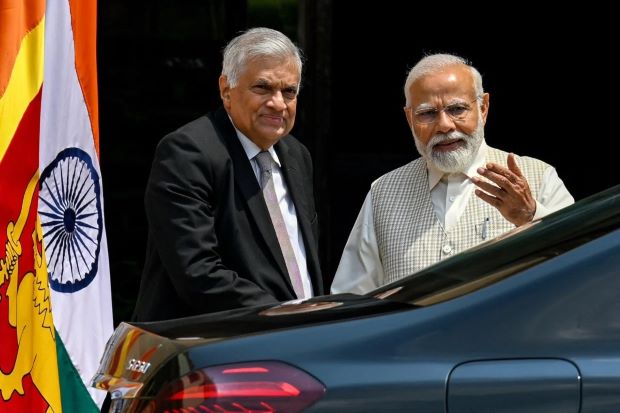India sees a chance to make Sri Lanka ‘a virtual province’ amid its rivalry with China
By Dimuthu Attanayake
India is set to wield greater influence in Sri Lanka as its companies flock to sign deals with the heavily indebted island nation in sectors ranging from energy to maritime logistics, even as some analysts question their commercial viability.
Among the recent high-profile deals involving Indian companies was a 20-year power purchase agreement with Adani Green Energy, a subsidiary of India’s Adani Group, announced by Sri Lankan President Ranil Wickremesinghe earlier this month.
Adani Green is building two 484 megawatt wind power stations in the town of Mannar and the village of Pooneryn in Sri Lanka’s Northern Province – to be added to the national grid by 2025 – for a cost of US$ 442 million.
The deal came six months after the US International Development Finance Corporation announced that it would provide US$ 553 million in financing for a port terminal project in Colombo being developed and partly owned by the Adani Group.
Last month, the Sri Lankan government awarded the management of Mattala Rajapaksa International Airport (MRIA) in southern Sri Lanka to an Indian-Russian joint venture comprising Shaurya Aeronautics (Pvt) Ltd of India and Airports of Regions Management Company of Russia.
Once dubbed “the world’s emptiest airport” due to its low traffic and underutilisation, the MRIA cost US$ 209 million to build, with funding from the Exim Bank of China.
“This [slew of deals] is the biggest opportunity India will ever get to turn Sri Lanka into a virtual province of India,” said Uditha Devapriya, the chief international relations analyst of Factum, a Sri Lankan foreign-policy think tank.
Sri Lanka is trying to turn its economy around as it seeks to emerge from bankruptcy and defer loan payments until 2028. Colombo declared bankruptcy in 2022 amid a crippling foreign-exchange crisis and suspended loan repayments totalling some US$ 83 billion.
In addition to the influx of Indian companies in Sri Lanka, New Delhi also provided US$ 4 billion in emergency financing to Colombo in 2022. Analysts say these moves are part of India’s strategy to increase its economic and business foothold in its neighbour.
As India pursues economic integration with Sri Lanka, it will continue to have leverage in negotiations, Devapriya said. “Sri Lanka is not in a position to say no.”
The MRIA lease, in particular, is seen by some analysts as a prime example of India gaining the upper hand over China in their rivalry to woo Sri Lanka.
In recent years, China has deepened its economic partnership with Sri Lanka by signing deals in sectors ranging from port management to oil and gas.
Sri Lanka announced in 2017 that the Chinese-built Hambantota port would be leased for 99 years to a Chinese government-linked company. Colombo also approved the development of a US$4.5 billion oil refinery flanking Hambantota by Chinese oil giant Sinopec in November.
Charana Kanankegamage, a Colombo-based lawyer and foreign-policy analyst, said Sri Lanka was not “devaluing” its relationship with China, despite the slew of deals involving Indian companies.
A key plank of Sri Lanka’s economic policy was to reap maximum benefits by relying on China and India to manage its underutilised or underperforming assets, he said.
The MRIA deal, on the other hand, represents “a pragmatic choice by Sri Lankan policymakers to achieve a positive outcome from their ambitious reforms”.
Some economists disagree. Kasun Thilina Kariyawasam, a macroeconomist based in Sweden, called the lease deal for the unprofitable and underutilised MRIA an example of Sri Lanka’s “myopic” economic policy – noting that arrivals would be boosted by tourists from India and Russia, according to Sri Lankan government projections.
“The focus is on the service sector, which is not going to be sustainable for the economy,” he said, adding that the country’s airport and port assets should instead serve as logistic hubs to support industrialisation activities.
Meanwhile, the Adani Green wind power deal has been criticized for its high price and lack of transparency.
Sri Lanka’s government says the Indian company will be paid 8.26 US cents per kilowatt-hour (kWh) under the deal. But Rohan Pethiyagoda, a Sri Lankan biodiversity scientist, told This Week in Asia that global electricity prices currently average between 2-3 US cents.
“This project had no tender procedure,” he said. “It was an unsolicited bid as far as we can tell.”
The project was likely awarded in this manner because it was “one of the foreign policy aims” of Indian Prime Minister Narendra Modi’s government, international relations analyst Devapriya said.
On Thursday (16), Sri Lankan conservation organisation The Wildlife and Nature Protection Society filed a petition with the island nation’s Supreme Court challenging the wind project on environmental grounds.
-Dimuthu Attanayake is an independent journalist and a researcher from Sri Lanka, covering business, tech, social issues, and the environment. This article was originally featured on scmp.com



Comments are closed, but trackbacks and pingbacks are open.